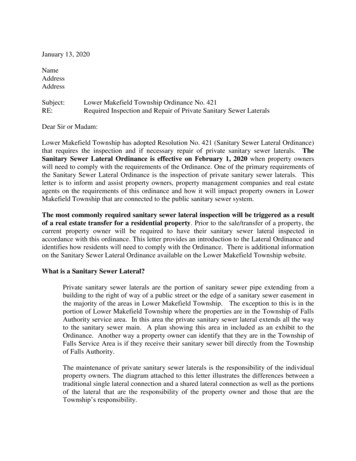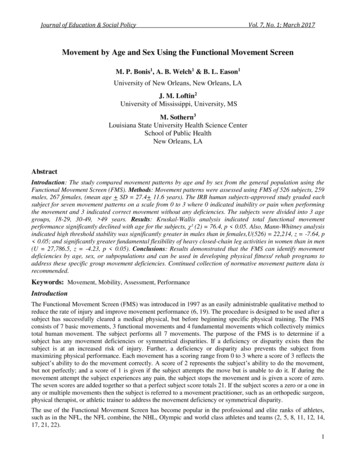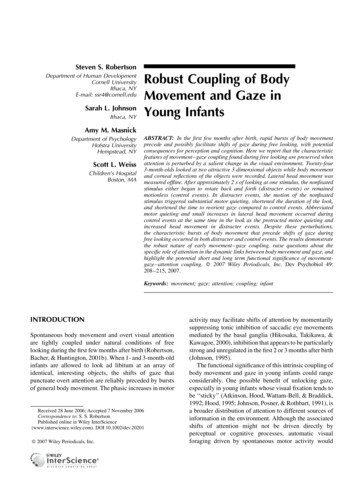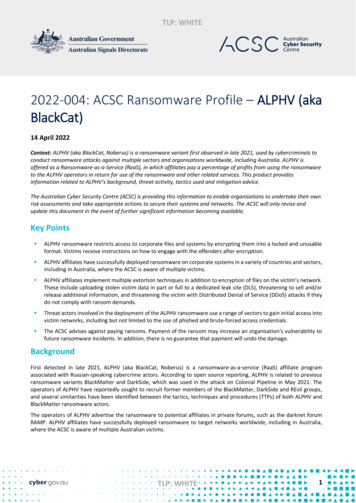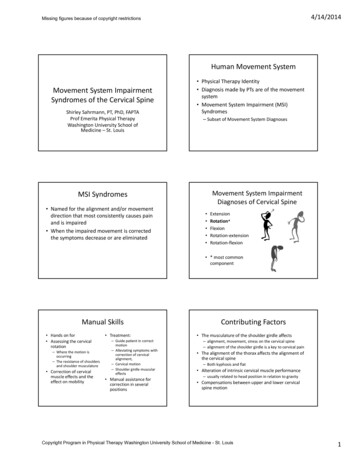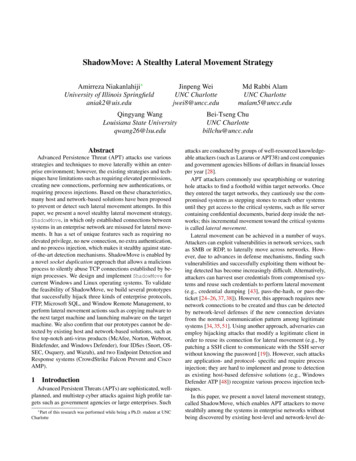
Transcription
ShadowMove: A Stealthy Lateral Movement StrategyAmirreza Niakanlahiji University of Illinois Springfieldaniak2@uis.eduJinpeng WeiUNC Charlottejwei8@uncc.eduQingyang WangLouisiana State Universityqwang26@lsu.eduAbstractAdvanced Persistence Threat (APT) attacks use variousstrategies and techniques to move laterally within an enterprise environment; however, the existing strategies and techniques have limitations such as requiring elevated permissions,creating new connections, performing new authentications, orrequiring process injections. Based on these characteristics,many host and network-based solutions have been proposedto prevent or detect such lateral movement attempts. In thispaper, we present a novel stealthy lateral movement strategy,ShadowMove, in which only established connections betweensystems in an enterprise network are misused for lateral movements. It has a set of unique features such as requiring noelevated privilege, no new connection, no extra authentication,and no process injection, which makes it stealthy against stateof-the-art detection mechanisms. ShadowMove is enabled bya novel socket duplication approach that allows a maliciousprocess to silently abuse TCP connections established by benign processes. We design and implement ShadowMove forcurrent Windows and Linux operating systems. To validatethe feasibility of ShadowMove, we build several prototypesthat successfully hijack three kinds of enterprise protocols,FTP, Microsoft SQL, and Window Remote Management, toperform lateral movement actions such as copying malware tothe next target machine and launching malware on the targetmachine. We also confirm that our prototypes cannot be detected by existing host and network-based solutions, such asfive top-notch anti-virus products (McAfee, Norton, Webroot,Bitdefender, and Windows Defender), four IDSes (Snort, OSSEC, Osquery, and Wazuh), and two Endpoint Detection andResponse systems (CrowdStrike Falcon Prevent and CiscoAMP).1IntroductionAdvanced Persistent Threats (APTs) are sophisticated, wellplanned, and multistep cyber attacks against high profile targets such as government agencies or large enterprises. Such Partof this research was performed while being a Ph.D. student at UNCCharlotteMd Rabbi AlamUNC Charlottemalam5@uncc.eduBei-Tseng ChuUNC Charlottebillchu@uncc.eduattacks are conducted by groups of well-resourced knowledgeable attackers (such as Lazarus or APT38) and cost companiesand government agencies billions of dollars in financial lossesper year [28].APT attackers commonly use spearphishing or wateringhole attacks to find a foothold within target networks. Oncethey entered the target networks, they cautiously use the compromised systems as stepping stones to reach other systemsuntil they get access to the critical systems, such as file servercontaining confidential documents, buried deep inside the networks; this incremental movement toward the critical systemsis called lateral movement.Lateral movement can be achieved in a number of ways.Attackers can exploit vulnerabilities in network services, suchas SMB or RDP, to laterally move across networks. However, due to advances in defense mechanisms, finding suchvulnerabilities and successfully exploiting them without being detected has become increasingly difficult. Alternatively,attackers can harvest user credentials from compromised systems and reuse such credentials to perform lateral movement(e.g., credential dumping [43], pass-the-hash, or pass-theticket [24–26, 37, 38]). However, this approach requires newnetwork connections to be created and thus can be detectedby network-level defenses if the new connection deviatesfrom the normal communication pattern among legitimatesystems [34, 35, 51]. Using another approach, adversaries canemploy hijacking attacks that modify a legitimate client inorder to reuse its connection for lateral movement (e.g., bypatching a SSH client to communicate with the SSH serverwithout knowing the password [19]). However, such attacksare application- and protocol- specific and require processinjection; they are hard to implement and prone to detectionas existing host-based defensive solutions (e.g., WindowsDefender ATP [48]) recognize various process injection techniques.In this paper, we present a novel lateral movement strategy,called ShadowMove, which enables APT attackers to movestealthily among the systems in enterprise networks withoutbeing discovered by existing host-level and network-level de-
fensive mechanisms as demonstrated in Section 5. We assumethat attackers want to avoid exploiting vulnerabilities in remote services during their operation to reduce the chance ofbeing exposed by intrusion detection systems (IDSes). In thisattack scenario, attackers passively observe communicationdynamics of the compromised systems to gradually constructtheir model of normal behaviors in the target network and utilize this model to choose the next victim system. Moreover, tomake the attack even stealthier, attackers restrict themselvesto only reuse established connections. Many application protocols such as WinRM (Windows Remote Management) andFTP allow users to perform some operations on the remoteserver. Attackers inject their own commands in the commandstreams of such protocols to achieve their goal. For example, attackers can execute a program remotely by injectingcommands in an established WinRM session (Section 4.4),or they can inspect the file system on the remote system byinjecting FTP commands in an established FTP connection(Section 4.2).ShadowMove does not use any code in benign client processes to inject fabricated commands. Instead, it employs anovel technique to secretly duplicate sockets owned by legitimate clients and injects commands through such stolensockets (Section 3.4). By doing so, no new connection will becreated and no new authentication will be performed as theinjected commands are interpreted in the context of alreadyestablished sessions; this means that the attacker does notneed to pass any authentication.In this work, we show how an attacker can implement suchan attack on a typical enterprise network. To this end, we develop a prototype system that can hijack existing TCP connections established by an FTP client (Section 4.2), a MicrosoftSQL client (Section 4.3), and a WinRM client (Section 4.4)running under the same user account as our prototype andwithout any elevated privileges. We also present a Prologbased planner that an attacker can utilize to systematicallyplan for lateral movement by hijacking available connections.In this way, the attacker can reach the critical systems significantly stealthier than existing attack scenarios. We discuss thetechnical challenges on how attackers can inject their packetsthat conform to the protocol running over an established TCPconnection and be acceptable to the server on the other endof the connection.We summarize our contributions as follows: We present a new class of lateral movements which is completely undetectable by existing network and host-baseddefensive solutions including IDSes, Antivirus, and EDR(Endpoint Detection and Response) systems. We propose a novel socket duplication technique that enables attackers to reuse connections established by otherprocesses on a compromised system. We, then, develop alateral movement framework on top of this technique. We demonstrate the feasibility of our idea by building aprototype system on Windows 10 that successfully hijacksFigure 1: ShadowMove Lateral MovementFTP, TDS (used by Microsoft SQL Server), and WinRMconnections for lateral movements. This Windows prototype demonstrates all features of ShadowMove, requiringno elevated privilege, no new connection, no extra authentication, and no process injection. We also build a prototypethat successfully hijacks FTP on Ubuntu 18.04 withoutrequiring elevated privilege, new connections, or extra authentication. However, the design is not as stealthy as itsWindows counterpart because it relies on process injection and requires stronger assumptions about the attacker(Section 3.4.3). We experimentally confirm that our prototypes can evadethe detection of five top-notch anti-virus products (McAfee,Norton, Webroot, Bitdefender, and Windows Defender),four IDSes (Snort, OSSEC, Osquery, and Wazuh), andtwo emerging Endpoint Detection and Response systems:CrowdStrike Falcon Prevent and Cisco AMP. It is important to point out that CrowdStrike Falcon Prevent is knownto detect lateral movements.The result of our study calls for a revisit of enterprise protocols in terms of their susceptibility to hijacking attacks.2ShadowMove ApproachThe basic idea of ShadowMove is to reuse established andlegitimate connections to laterally move within the compromised network. As shown in Figure 1, ShadowMove works inthree main steps: first, it silently duplicates a socket used bya legitimate client application to communicate with a serverapplication; second, it uses the duplicated socket to injectpackets in the existing TCP session between the client andthe server; third, the server handles the injected packets andunintentionally saves and/or launches a new instance of ShadowMove. As a result of these steps, an attacker stealthilymoves from the client machine to the server machine.Since ShadowMove restricts itself to reuse established connections to neighboring systems, it can ensure intrusion detection systems that raise alarms for unexpected connectionscannot detect its operation. Moreover, by doing so, the attackcan bypass the authentication phase required for establishinga new connection. ShadowMove attack is noteworthy fromboth a host security perspective and a network security perspective: at the host level, ShadowMove abuses resourcesowned by a victim process (i.e., established and authenticatednetwork connections); on the other hand, because what Shad-
owMove abuses are sockets, its attack actions extend to thenetwork level, by blending malicious network traffic withbenign network traffic.2.1Fundamental Weaknesses Exploited byShadowMoveTwo fundamental weaknesses in the existing computingenvironment enable ShadowMove attacks. The first weaknessstems from the two conflicting but essential requirements,namely process isolation and resource sharing, in commodityoperating systems such as GNU Linux and Microsoft Windows. The next weakness arises from the fact that many of theexisting networking protocols lack proper built-in messageorigin integrity validation mechanisms, which makes themsusceptible to message injection attacks.Process isolation and process (resource) sharing are conflicting requirements. A process has a virtual address space,open handles to system objects, and other attributes. All processes in an operating system must be protected from eachother’s activities, for reliability and security reasons [52]. Theprotection mechanism of a modern OS isolates the accessto different kinds of resources (e.g., CPU, memory, and I/Odevices) among processes. For example, memory isolationputs each process into its own “address space”. On the otherhand, modern OSes support sharing among processes becausesharing of data/resources can be useful. Take socket sharingfor example, one process first creates sockets and establishesconnections, then it hands off those sockets to other processesthat will be in charge of information exchange through thosesockets. However, sharing among processes has risks, so ithas to be carefully controlled. Modern OSes assume thatprocesses that share resources trust each other by setting upappropriate security policies to control the access to sharedobjects, to ensure the safety of such sharing (e.g., [36]).Unfortunately, the default access control policy of commodity OSes suffers from wrong assumptions about processtrust relationship. For example, the built-in Windows securitypolicy allows processes by the same user to share their openhandles to resources, and the built-in Linux policy allows aparent process to access memory of a child process throughptrace [3]. These default allow policies assume a trust relationship among processes of the same user or between a parentprocess and a child process, which is not realistic in today’scomputing environments. As a result, such default allow policies can be abused by an attacker. In this paper, we present aconcrete example, socket duplication attack, which enables amalicious process to impersonate a legitimate process in theinteraction with an external entity over the network.Another underlying problem that enables ShadowMove isthe lack of proper message origin integrity checks in manyapplication protocols such as FTP and TDS (for MS SQL). Asa result, endpoints cannot verify the origins of the messagesto ensure that the messages are not interleaved by maliciousactors. An attacker who duplicated a socket can interject arequest in between requests of a client and mislead the serverto think the original client sent it, thus processing the request.We can divide application protocols into three categorieswith regard to enforcing message origin integrity: No origin integrity enforcement. Such protocols do nothave any built-in mechanisms that enable the server tocheck the origin integrity of the received messages, so anyproper message that conforms with the protocol is acceptedby the server. They are susceptible to ShadowMove attacksand one representative protocol is FTP. Inadequate origin integrity enforcement. In these protocols, the server generates a random nonce for the client touse along with its requests, and the server uses this nonceto validate the origin of received requests. Unfortunately,these protocols are not safe against ShadowMove becausethe attacker can wait for the client to create new connections and listen to the response from the server to learn thenonce. One representative protocol is WinRM. Adequate origin integrity enforcement. In these protocols, part of the information needed for validating originintegrity is generated by the client and not by the server. Inthis case, there is no way an attacker can learn that pieceof information by listening to server response. These protocols are immune to ShadowMove and one representativeprotocol is SSL.2.2Threat ModelWe assume that attackers have established a foothold on avictim system under a normal user’s privilege, and they wantto make a lateral movement towards the critical asset(s). Theattackers have to run malware to achieve this. We assumethat the victim process whose TCP connection is going to behijacked is not aware of the malware process.Demonstration Scenario We use an Employee Selfservice Application of a company as an example. This isa typical multi-tier enterprise application that can be accessedfrom a browser. Below is the description of the componentsof such a system: Employee desktop computers, which run the web client.Some employees are IT personnel at the same time, andthey need to occasionally push content to the applicationserver, so their computers have file copying tools (such asFTP) installed. Application server, which runs many applications such aspayroll, stock, health insurance, retirement plan, and travel. Database server, which stores personnel information suchas DOB, SSN, contact info, and salary, and is accessed bythe application server.In this example, attackers landed on an employee desktop(via spearphishing), and this employee happens to be an ITpersonnel. The critical assets that the attackers go after is employee information stored on the database server. Therefore,attackers need to move from the desktop to the application
Figure 2: ShadowMove Architectureserver then to the database server. Moreover, they need tohave some tool persist on the database server in order to getdaily reports about updates to employee records.To move from the desktop to the application server,the attacker can leverage the FTP connection (see Section 4.2) to copy a piece of malware to the application server and wait for the malware to be executed. Forexample, it is common that an application server canrun an external program (e.g., data processing app implemented in C) in a path specified in a configurationfile [4]. The configuration file may contain “commandname C : \users\alluser\appdata\updater\d panalyzer.exe” andbased on this the application server executes d panalyzer.exeonce some relevant event is triggered. To keep the applicationserver up to date, an IT personnel is authorized to copy filesto the application server in order to update d panalyzer.exe.Under this circumstance, the attacker can leverage the FTPconnection to copy a piece of malware to the applicationserver to replace the legitimate d panalyzer.exe and then waitfor the malware to be executed by the application server. Theattacker can get the configuration file’s content via the sameFTP connection.When the malware is launched on the application server(e.g., as d panalyzer.exe), it can leverage the database connection (such as Microsoft SQL discussed in Section 4.3)between the application server and the database server tocopy and launch further malware on the database server.3ShadowMove Architecture and DesignFigure 2 depicts the overall architecture of ShadowMove,which consists of six major modules: Connection Detector,Socket Duplicator, Peer Handler, Network View Manager,Lateral Movement Planner, and Plan Actuator.Central to the ShadowMove design is the notion of NetworkView, which represents a model of the normal network communication pattern in the victim environment, collectivelymaintained by ShadowMove instances running on differentvictim systems. Figure 6 gives an example network view. EachShadowMove instance maintains two views: the local viewis based on the current connections in the local system, andthe global view is constructed by exchanging and propagatinginformation among ShadowMove instances.The Connection Detector module (Section 3.1) is responsible for detecting newly-established TCP connections thatcan be exploited for lateral movement and requesting theSocket Duplicator to duplicate the corresponding socket. Italso detects the teardown of TCP connections and notifies theNetwork View Manager.The Socket Duplicator (Section 3.4) duplicates socketsowned by target processes and passes along such sockets toits caller together with additional contextual information suchas the PIDs of the owner processes.The Peer Handler (Section 3.2) communicates with neighboring ShadowMove instances to synchronize their views ofthe compromised network. On one hand, it updates the Network View Manager with information learned from its peers(e.g., newly discovered hosts); on the other hand, it sends thenetwork view of the local ShadowMove instance to its remotepeers.The Network View Manager (Section 3.3) combines a fewmethods to maintain a global view of the victim network,based on notifications from the Connection Detector and thePeer Handler. It also determines the service type supportedby each duplicated socket and maintains the liveness of theduplicated sockets.Periodically, the Lateral Movement Planner (Section 3.5)creates a lateral movement plan based on the current networkview and the capabilities supported by the duplicated sockets.The plan specifies the socket that must be used, the type ofaction that must be carried out, and the payload.Finally, the Plan Actuators (Section 3.6) execute individualsteps in a lateral movement plan, such as transferring a fileto the remote server, by sending packets to and/or receivingpackets from the given sockets.3.1ShadowMove Connection DetectorTwo approaches exist for detecting and tracking TCP connections. First, we can periodically poll TCP connection information and compare the returned information with theresult of the previous call. This approach is used by toolssuch as TCPView on Windows. A second approach is eventdriven in which we register an event handler for the creationor teardown of connections. In Windows OS, one can get information about connection state changes by creating a WMI(Windows Management Instrumentation) filter and registeringa WMI event consumer [57]. However, registering a WMIevent consumer requires administrative privilege.As a result, we choose the first approach. By callingGetTcpTable2 and GetTcp6Table2 on Windows, or by running the command netstat -ntp on Linux, the Connection Detector can get basic information about TCP connections, such as connection state, local IP address, local port,remote IP address, remote port, and the ID of the owner process [42]. From the process ID it can further get the processname. When the Connection Detector observes a connectionstate change from non-ESTABLISHED to ESTABLISHED,
Figure 3: ShadowMove - Synchronization Signalit invokes the Socket Duplicator about the new TCP connection and then notifies the Network View Manager to add theduplicated socket into the pool. On the other hand, when itobserves a connection state change from ESTABLISHED tonon-ESTABLISHED, it notifies the Network View Managerto remove a duplicated socket from the pool because the associated TCP connection becomes unusable. The notificationmessage contains basic information of the TCP connectionand the owner process name.On Windows, the Connection Detector does some simplefiltering of TCP connections before it notifies the Socket Duplicator or the Network View Manager. Specifically, it checkswhether the ShadowMove process has enough permissionto open the owner process of a TCP connection with PROCESS DUP HANDLE access flag, and it skips those connections for which the ShadowMove process does not haveenough permission.3.2Peer HandlerThe Peer Handler module enables ShadowMove instancesto share their views of the compromised network with theirneighboring ShadowMove instances. Each instance I uses theshared information to construct a global view of accessiblesystems via already-compromised systems. The Peer Handlermodule is executed in a separate worker thread.Upon execution, the Peer Handler attempts to locate a configuration file in the working directory of I. This file containsinformation about the TCP connection that was used to moveI to the current system. ShadowMove then determines thecorresponding server process and the socket that were misused by the predecessor ShadowMove instance. It duplicatesthis socket by calling the Socket Duplicator module and thencontinuously listens to the incoming traffic of the duplicatedsocket.As shown in Figure 3, on a regular basis, the predecessor ShadowMove suspends the client process and then sendsa special request to the remote server. Upon receiving this“signal” message, the successor ShadowMove suspends theserver process. Then these two ShadowMove instances cansynchronize their knowledge about the network using a protocol similar to the distance vector routing protocol [56].3.3Network View ManagerThis module maintains a global view of the victim networkbased on information received from the Connection Detectorand the Peer Handler.It manages the Duplicated Socket Pool and keeps a tuple connection state, local IP address, local port, remote IP address, remote port, service type, owner PID, owner processname for each socket in the pool. Most of these fields arepassed in by the Connection Detector, except for service type(or protocol), which it determines in a sub-module calledLayer 7 Protocol Detector by combing a few methods. First,it guesses from the destination port because many servicesrun behind well-known default ports [11], e.g., the defaultport number for FTP is 21. Second, it guesses from the ownerprocesses if they are well-known client-side tools for someservices, e.g., ssms.exe or the Microsoft SQL Server Management Studio is a client of SQL server. Finally, if the port number and the owner process information are not sufficient for areliable guess, it passively sniffs the network traffic by callingthe recv API on each socket and setting the MSG PEEKflag. Then it analyzes the received payload to recognize theapplication-level protocol, leveraging existing protocol analysis techniques such as automatic protocol detection feature inSuricata [55].Based on the Duplicated Socket Pool, the Network ViewManager computes a local view, which can be representedby several predicates shown in Table 2: a system predicatedefines the IP address of a host, and a connected predicatedefines connections between two systems. When it receivesnotifications from the Peer Handler, which are system andconnected predicates shared by the neighbors, it updates itsglobal view by merging the predicates into its local view.It is worth noting that, in Windows, closing a socket doesnot always entail in TCP connection termination handshake.The termination handshake occurs only when the last socketdescriptor is closed. As a result the connections will remainopen even if owner processes close their sockets. However, aTCP connection may be not usable because of several reasonssuch as network failure, remote process crash, or connectioninactivity timeout. To prevent connection inactivity timeout tooccur, the Network View Manager sets the SO KEEPALIVEflag for all duplicated sockets using setsockopt API function; by doing so, keep-alive packets will be sent throughthese connections automatically.3.4ShadowMove Socket DuplicatorThe Socket Duplicator duplicates sockets associated withgiven TCP connections when it receives a request from theConnection Detector or the Peer Handler. The underlying ideaof our approach is to duplicate the socket inside the targetprocess and to use the resulting socket to secretly access theestablished TCP connection.3.4.1 Socket Duplication on WindowsOn Windows, one can call DuplicateHandle API to duplicate different types of handles from a remote process. However, as mentioned in DuplicateHandle documentation [40],this function cannot be used to duplicate sockets.
Although WindowsoffersanAPInamedWSADuplicateSocket to duplicate a socket, we cannot directly use this function as it requires cooperationbetween the processes. As mentioned in [41], a typical scenario of using this function goes as follows. A source processcreates a socket and wants to share it with a destination process. First, the source process calls WSADuplicateSocketto get a special WSAPROTOCOL INFO structure. This infostructure is given to the destination process via inter-processcommunication (IPC) mechanism. The destination processpasses the info structure to WSASocket to reconstruct thesocket on its side. The main challenge in this approach (i.e.,using WSADuplicateSocket) is that both processes mustcooperate with each other to duplicate a socket, which isnot the case in our scenario where the attacker wants toduplicate a socket from an unwary victim process. One wayto address this issue is to inject code into the victim processto implement the missing steps due to a lack of cooperation.However, existing defense mechanisms such as WindowsDefender ATP flag usages of common process injectiontechniques [48], which makes the solution less attractive.We devised a novel technique, by using Windows APIs inan unconventional way, that enables an attacker process toduplicate a socket from a target process without requiringits cooperation. Table 1 depicts the steps that the attackerprocess performs to duplicate a socket from a target process,assuming it knows the process ID of the target, thanks toreal-time connection detection (Section 3.1). First, it opensthe target process by using OpenProcess to enumerate allof the open handles in the target. The attacker process onlyseeks for file handles with the name of \device\afd (steps3-5, and afd stands for ancillary function driver). During thisoperation, the attacker process duplicates all file handles asit is required for reading the name of a handle. We discoverthat the attacker process could treat these duplicated afd handles as sockets. To locate the exact socket corresponding to aTCP connection, the attacker process obtains the remote IPaddress and remote port to which the afd handle of socket isconnected (by invoking getpeername) and compares themwith the information passed in by the Connection Detector. Ifthere is a match, the attacker process passes the afd handle toWSADuplicateSocketW to obtain the information necessaryfor duplication of the original socket. After obtaining the protocol info structure, the attacker process calls the WSASocketWfunction to duplicate the socket. This socket is then saved inthe Duplicated Socket Pool together with context information such as the owner PID, the owner process name, local IPaddress, local port, remote IP address, and remote port.It is also worth noting that on Windows, the TCP connection tables for IPv4/6 only contain information about theoriginal socket descriptors not the duplicated ones and theowner PID of a socket descriptor will never change even afterthe termination of the owner process. This means that conventional tools such as netstat, which rely on Windows APIsto retrieve TCP connection tables, cannot be used to detectwhether a connection is duplicated and nor its duplicators.3.4.2Deep Dive into Socket Duplication on WindowsTo understand why ShadowMove’s socket duplicationworks, it is necessary to first understand socket context. Thewinsock2 libraries maintain socket context for each sockethandle in a number of data structures at different layers( [58] and Figure 4). Inside WS2 32.dll, there is a hash tablecalled sm context table, which maps a socket handle toa DSOCKET object that stores information about the socketsuch as the process and service provider. At the next layer,mswsock.dll (a service provider), there is another hash tablecalled SockContextTable, which maps a socket handle to aSOCKET INFORMATION object, which stores information suchas socket state, reference count, local address, and remoteaddress. Every user-level operation on the socket, such asconnect,
the detection of five top-notch anti-virus products (McAfee, Norton, Webroot, Bitdefender, and Windows Defender), four IDSes (Snort,OSSEC, Osquery, and Wazuh),and two emerging Endpoint Detection and Response systems: CrowdStrike Falcon Prevent and Cisco AMP. It is impor-tant to point out that CrowdStrike Falcon Prevent is known
